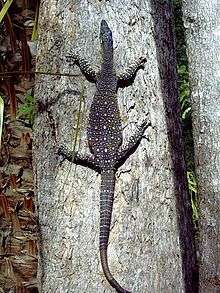Lace monitor
| Lace monitor | |
|---|---|
 | |
| Scientific classification | |
| Kingdom: | Animalia |
| Phylum: | Chordata |
| Class: | Reptilia |
| Order: | Squamata |
| Family: | Varanidae |
| Genus: | Varanus |
| Subgenus: | Varanus |
| Species: | V. varius |
| Binomial name | |
| Varanus varius (Shaw, 1790) | |
| Synonyms | |
|
Lacerta varius Shaw, 1790 | |
The lace monitor or lace goanna (Varanus varius) is a member of the monitor lizard family, Australian members of which are commonly known as goannas. It belongs to the subgenus Varanus.[1]
Lace monitors are the second-largest monitor in Australia after the perentie. They can be as long as 2.1 m (over 6.8 ft) with a head-and-body length of up to 76.5 cm (2.5 ft). The tail is long and slender and about 1.5 times the length of the head and body.[2][3] The maximum weight of lace monitor can be 20 kg (44 lb), but most adults are much smaller.
These common terrestrial and often arboreal monitors are found in eastern Australia and range from Cape Bedford on Cape York Peninsula to south-eastern South Australia. They frequent both open and closed forests and forage over long distances (up to 3 km a day).
They are mainly active from September to May, but are inactive in cooler weather and shelter in tree hollows or under fallen trees or large rocks.
The females lay four to 14 eggs in spring or summer in termite nests. They frequently attack the large composting nests of scrub turkeys to steal their eggs, and often show injuries on their tails inflicted by male scrub turkeys pecking at them to drive them away.
Their diets typically consist of insects, reptiles, small mammals, birds, and birds' eggs. They are also carrion eaters, feeding on already dead carcasses of other wildlife. Lace monitors will also forage in areas inhabited by people, raiding chicken coops for poultry and eggs, rummaging through unprotected domestic garbage bags, and rubbish bins in picnic and recreational areas.
They are preyed upon by dingoes and birds of prey, and like all Australian goannas, they were a favourite traditional food of Australian Aboriginal peoples, and their fat was particularly valued as a medicine and for use in ceremonies.
Patterning
Lace monitors are found in two broad forms. The main form is dark grey to dull blueish-black with numerous, scattered, cream-colored spots. The snout is marked with prominent black and yellow bands extending under the chin and neck. The tail has narrow black and cream bands which are narrow and get wider towards the end of the tail.
The other type, known as Bells form, is typically found in dryer parts of NSW and Queensland. It has broad, black and yellow bands across the body and tail. Close up, these bands are made up of various spotted patterns.
Venom
In late 2005, University of Melbourne researchers discovered the perenties (V. giganteus) and other monitor lizards may be somewhat venomous. Previously, bites inflicted by these lizards were thought to be simply prone to infection because of bacteria in the lizards' mouths, but these researchers have shown the immediate effects may be caused by mild envenomation.[4]
Other scientists such as Washington State University biologist Kenneth V. Kardong and toxicologists Scott A. Weinstein and Tamara L. Smith, have stated that this allegation of venom glands "has had the effect of underestimating the variety of complex roles played by oral secretions in the biology of reptiles, produced a very narrow view of oral secretions and resulted in misinterpretation of reptilian evolution". According to these scientists "reptilian oral secretions contribute to many biological roles other than to quickly dispatch prey". These researchers concluded that, "Calling all in this clade venomous implies an overall potential danger that does not exist, misleads in the assessment of medical risks, and confuses the biological assessment of squamate biochemical systems".[5]
Gallery
 Molting in Queensland
Molting in Queensland Goanna coming down a tree outside Cooktown, Queensland, Australia in April 2013
Goanna coming down a tree outside Cooktown, Queensland, Australia in April 2013- Variety: Bells form - Fraser Coast, Queensland, Australia
 Varanus varius prowling demonstrating camouflage
Varanus varius prowling demonstrating camouflage Lace monitor climbing a tree
Lace monitor climbing a tree Lace monitors fighting
Lace monitors fighting Climbing a tree
Climbing a tree Climbing a tree
Climbing a tree Wild lace monitor in Brisbane Forest Park
Wild lace monitor in Brisbane Forest Park.jpg) Lace Monitor (Glenrock State Conservation Area) - Newcastle. New South Wales. Australia.
Lace Monitor (Glenrock State Conservation Area) - Newcastle. New South Wales. Australia.
Footnotes
- ↑ Kingsnake.com
- ↑ Ehmann, Harald. (1992). Encyclopedia of Australian Animals: Reptiles, p. 158. The Australian Museum. ISBN 0-207-17379-6 (Reptiles).
- ↑ Wildlife of Tropical North Queensland: Cooktown to Mackay, p. 233. (2000). Queensland Museum. ISBN 0-7242-9349-3
- ↑ Goanna venom rocks the reptile record, UniNews Vol. 14, No. 22 28 November - 12 December 2005, University of Melbourne, Retrieved March 8, 2006
- ↑ Weinstein, Scott A.; Smith, Tamara L.; Kardong, Kenneth V. (14 July 2009). "Reptile Venom Glands Form, Function, and Future". In Stephen P. Mackessy. Handbook of Venoms and Toxins of Reptiles. Taylor & Francis. pp. 76–84. ISBN 978-1-4200-0866-1. Retrieved 18 July 2013.
References
- King, Dennis & Green, Brian. (1999). Goannas: The Biology of Varanid Lizards. University of New South Wales Press. ISBN 0-86840-456-X
- Wilson, Steven & Swan Gerry (2003). A Complete Guide to Reptiles of Australia. Reed New Holland Australia ISBN 1-876334-72-X
- Wilson, Stephen K. (1985). Australia's Reptiles. ISBN 0-207-17707-4.